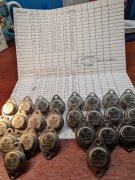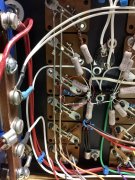Steve K
Journeyman
Time to play “Stump the Experts”. I am working on a 700b I’ve had for a few years. I’ve installed one of Joes rev g boards along with new power supply caps, rectifier, arc fuse holders, input jacks, iec outlet, dc protect board, new wiring, and new resistors on the original backplanes. Now for the problem. I installed the first three rows of transistors separately, monitoring bias voltage. The board has 15.4 volts +&-. Everything looked great. I was using a variac and DBT which was glowing a very dull orange color. I installed the 4th row and that is when disaster struck! One of the screws for the transistor closest to the transformer made contact with the 10 ohm resistor that sits there. When I increased the voltage going slowly the bulb stayed bright and I lost the bias reading from the test point. I don’t think I went beyond 30 volts on the variac. No smoke, no pops, no flames. I removed that 4th row and powered it up again and the bulb was orange like it should be. Still have 15 volts on the board. At this point I’m guessing I toasted one or more transistors on the board but this is where my skills are lacking. I’m not sure which components might have been affected. I’ll also need help testing them. I’ve been a member here for a number of years but this is my first adventure in working on one of these. I’m a retired mechanic by trade and have a bad habit of trying to resurrect anything broken. I have a variac, DBT, and a Fluke meter, and a large supply of hammers if necessary. Any and all help, comments, criticism, or anything else would be greatly appreciated. Another question; why does this affect bias on both channels?


